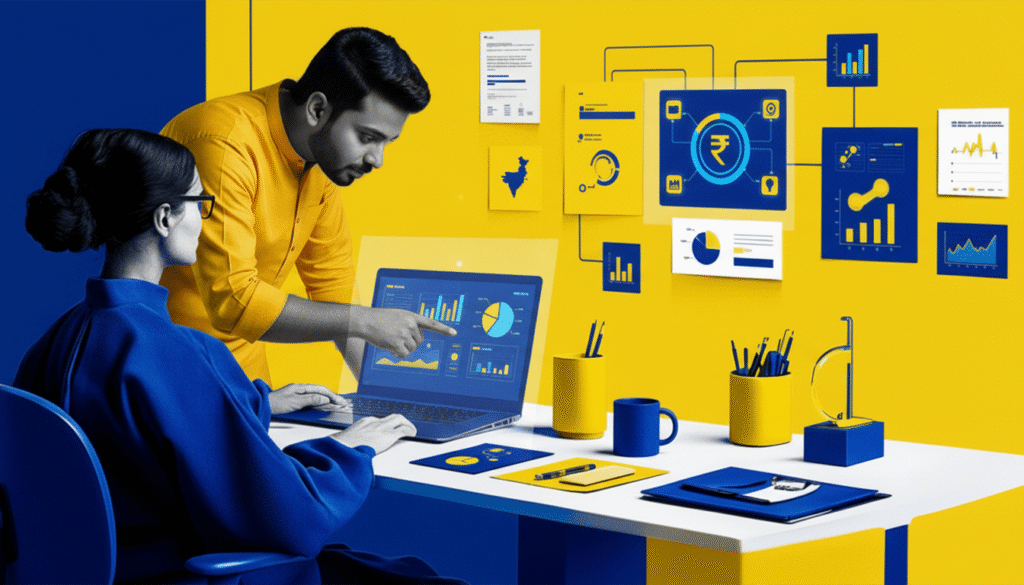When Rohit started his small textile business in Surat three years ago, he had one major problem.
His competitors established players with decades of experience were dominating Google search results, social media, and customer conversations. Meanwhile, his monthly marketing budget? A modest ₹45,000.
Sound familiar?
Here’s what most Indian SMBs don’t realize: You don’t need lakhs of rupees to compete with industry giants.
In fact, some of the most successful digital marketing campaigns we’ve seen came from businesses with budgets under ₹50,000 per month.
But there’s a catch.
You need to be strategic.
Today, We are going to show you exactly how to maximize every rupee of your digital marketing budget. This is the same framework that helped Rohit increase his online orders by 340% in 18 months while spending less than his competitors on marketing.
Let’s dive in.
The ₹50,000 Digital Marketing Reality Check
First, let’s address the elephant in the room.
₹50,000 per month isn’t a lot when you’re competing against companies spending ₹5 lakhs or more on digital marketing.
But here’s what recent research reveals:
According to a comprehensive study on Indian SMEs, over 60% of small businesses in India have adopted digital marketing strategies. However, most are making critical mistakes that drain their budgets without delivering results.
The top challenges identified?
- Lack of familiarity with analytics (68% of respondents)
- Limited resources for consistent campaigns (71%)
- Difficulty keeping up with changing digital trends (59%)
But here’s the good news: These same challenges create massive opportunities for SMBs who get their strategy right.
The 70-20-10 Budget Allocation Framework
After analyzing successful digital marketing campaigns from over 200 Indian SMBs, we discovered a pattern.
The businesses that consistently outperformed their competitors followed a specific budget allocation model:
70% – High-Impact, Low-Cost Channels
- Search Engine Optimization (SEO)
- Content Marketing
- Social Media Organic Growth
20% – Targeted Paid Advertising
- Google Ads (Search campaigns only)
- Facebook and Instagram ads for local targeting
10% – Tools and Analytics
- Essential marketing tools
- Performance tracking software
This isn’t just theory. Let me show you exactly how to implement this framework.
Step 1: Master Local SEO (Budget: ₹20,000/month)
Local SEO is your secret weapon.
Why? Because your competitors are probably ignoring it.
While they’re fighting for national keywords, you can dominate local search results with a fraction of their budget.
Here’s your action plan:
Week 1-2: Google My Business Optimization
- Complete your GMB profile (100% free)
- Add high-quality photos of your products/services
- Collect customer reviews systematically
- Post weekly updates about offers and new products
Week 3-4: Local Keyword Research Focus on keywords like:
- “[Your service] in [Your city]”
- “Best [Your product] near me”
- “[Your city] [Your industry]”
Ongoing: Content Creation Create blog posts targeting local searches:
- “Top 10 [Your Product] Suppliers in [Your City]”
- “Why [Your City] Businesses Choose [Your Solution]”
- Customer success stories from local clients
Real Example: A small manufacturing unit in Pune increased their local search visibility by 280% in 6 months by creating city-specific landing pages and consistently publishing local industry insights.
Step 2: Build Your Content Engine (Budget: ₹15,000/month)
Content marketing delivers the highest ROI of any digital marketing channel.
But most Indian SMBs are doing it wrong.
They create generic content that doesn’t address their customers’ specific pain points. Instead, you need to become the go-to resource in your niche.
The Content Strategy That Works:
Blog Posts (2-3 per month):
- Industry-specific tutorials
- “How to choose” guides for your products/services
- Local market insights and trends
Video Content (1-2 per month):
- Product demonstrations
- Behind-the-scenes content
- Customer testimonials
Social Media Content (Daily):
- Quick tips and insights
- Industry news commentary
- User-generated content
Pro Tip: Repurpose every piece of content across multiple channels. One blog post can become:
- 5 social media posts
- 1 video script
- 3 email newsletter sections
- Multiple ad copy variations
Step 3: Strategic Paid Advertising (Budget: ₹10,000/month)
With a limited budget, every paid advertising rupee must count.
Here’s how to maximize your ad spend:
Google Ads Strategy:
- Focus ONLY on high-intent keywords
- Target local areas within 25km radius
- Use negative keywords aggressively
- Start with manual bidding to control costs
Facebook/Instagram Ads:
- Create lookalike audiences based on existing customers
- Use video ads for higher engagement
- Target specific demographics and interests
- A/B test ad creative weekly
Budget Split:
- Google Ads: ₹6,000/month
- Facebook/Instagram: ₹4,000/month
Step 4: Leverage Free and Low-Cost Tools (Budget: ₹5,000/month)
The right tools can 10x your marketing efficiency.
Here are the essentials:
Free Tools:
- Google Analytics 4 (website tracking)
- Google Search Console (SEO monitoring)
- Canva (design and graphics)
- Buffer (social media scheduling)
Paid Tools Worth the Investment:
- SEMrush or Ahrefs (₹2,000/month) for keyword research
- Mailchimp (₹1,500/month) for email marketing
- Hootsuite (₹1,500/month) for social media management
The Cultural Advantage: Marketing That Resonates
Here’s where Indian SMBs have a massive advantage over international competitors.
You understand your local market’s cultural nuances.
Use this to your benefit:
Festival Marketing: Plan campaigns around major festivals in your region. A Diwali promotion in October or a Ganesh Utsav special in August can deliver 3-4x better engagement than regular campaigns.
Regional Language Content: Create content in local languages alongside English. Businesses using Hindi, Tamil, Bengali, or other regional languages in their digital marketing see 40% higher engagement rates.
Local Partnership Opportunities: Collaborate with other local businesses for cross-promotion. This costs nothing but can expand your reach significantly.
Advanced Tactics for Maximum Impact
Once you’ve mastered the basics, implement these advanced strategies:
Email Marketing Automation: Set up automated email sequences for new subscribers, abandoned carts, and repeat customers. This can increase your customer lifetime value by 25-30%.
Influencer Partnerships: Partner with micro-influencers (1,000-10,000 followers) in your local area. They’re more affordable and often deliver better ROI than macro-influencers.
Customer Referral Programs: Implement a simple referral system. Word-of-mouth marketing is still the most trusted form of advertising in India.
Measuring Success: The KPIs That Matter
Track these metrics to ensure your ₹50,000 is working hard:
Traffic Metrics:
- Organic website traffic growth
- Local search rankings
- Social media reach and engagement
Lead Generation:
- Cost per lead
- Lead conversion rate
- Customer acquisition cost
Revenue Impact:
- Return on ad spend (ROAS)
- Customer lifetime value
- Monthly recurring revenue growth
The 90-Day Quick Win Plan
Days 1-30: Foundation Building
- Set up Google My Business
- Launch basic SEO efforts
- Create content calendar
- Begin email list building
Days 31-60: Content Amplification
- Publish 2-3 blog posts
- Launch social media campaigns
- Start small paid ad campaigns
- Collect customer testimonials
Days 61-90: Optimization and Scale
- Analyze performance data
- Optimize best-performing campaigns
- Expand successful content topics
- Introduce referral programs
Common Mistakes That Drain Your Budget
Avoid these budget killers:
- Spreading your efforts across too many channels
- Ignoring mobile optimization (70% of Indian internet users are mobile-first)
- Not tracking conversions properly
- Competing on price instead of value
- Neglecting customer retention for new acquisition
The Path Forward
Digital marketing success for Indian SMBs isn’t about having the biggest budget.
It’s about being smarter, more focused, and culturally relevant than your competitors.
At GoSeen, we’ve helped hundreds of Indian SMBs transform their digital presence without breaking the bank. We understand the unique challenges you face from limited budgets to local competition and we’ve developed proven strategies that deliver results.
Whether you’re a manufacturing unit in Gujarat, a retail store in Karnataka, or a service provider in Maharashtra, we can help you compete with much larger competitors.
The key is consistency, measurement, and continuous optimization.
Your competitors might have bigger budgets, but you have something they don’t: the ability to be agile, personal, and deeply connected to your local market.
We Goseen Use that advantage. because At Goseen, we don’t just deliver ROI we deliver ROIs (Return on Ideas). Contact Goseen today to explore how we can make your vision a reality.
Frequently Asked Questions
Q: Can I really compete with larger companies with just ₹50,000 per month?
A: Absolutely. By focusing on local SEO, creating valuable content, and targeting specific niches, small budgets can achieve significant results. We’ve seen SMBs outrank competitors spending 10x more by being more strategic and focused.
Q: How long before I see results from digital marketing?
A: SEO and content marketing typically show results in 3-6 months, while paid advertising can generate leads within days. The key is having realistic expectations and maintaining consistency in your efforts.
Q: Should I hire an agency or build an in-house team?
A: For budgets under ₹50,000, working with a specialized agency often provides better ROI. You get access to expertise, tools, and experience without the overhead of hiring full-time employees.
Q: What’s the biggest mistake Indian SMBs make in digital marketing?
A: Trying to copy strategies from international businesses without adapting them to Indian market conditions. Cultural relevance, local language content, and understanding regional preferences are crucial for success.
Q: How do I track if my marketing budget is generating returns?
A: Set up proper tracking using Google Analytics, implement call tracking, and create unique landing pages for each campaign. Focus on metrics that directly correlate with revenue, not just vanity metrics like likes or impressions.




